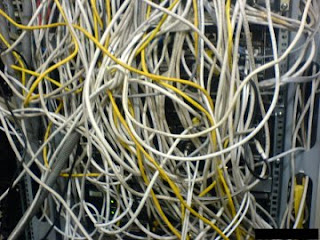Web-god Tim Berners-Lee posted a theoretical blog on the social graph early last week. He argued that networked computing has gone through three stages. First there was the net, the network infrastructure of the internet. Once users were free from having to physically connect individual machines that they wanted to network, they were able to ignore the network, or the cables, and focus on the computers themselves. According to Berners-Lee, when users could focus on the more important half of this binary, they were able to get more use from the net, and their ability was even more enhanced by enabling the reuse of underused or forgotten resources.
He argued that networked computing has gone through three stages. First there was the net, the network infrastructure of the internet. Once users were free from having to physically connect individual machines that they wanted to network, they were able to ignore the network, or the cables, and focus on the computers themselves. According to Berners-Lee, when users could focus on the more important half of this binary, they were able to get more use from the net, and their ability was even more enhanced by enabling the reuse of underused or forgotten resources. The next level of networking was the web. Because it combined the resources of different machines and connected them together seamlessly, the world wide web allowed users to focus not on the computers, but on the documents. The document of choice, of course, was the web page, which, like the computers of the net, became the focal point of web browsing.
The next level of networking was the web. Because it combined the resources of different machines and connected them together seamlessly, the world wide web allowed users to focus not on the computers, but on the documents. The document of choice, of course, was the web page, which, like the computers of the net, became the focal point of web browsing. At the third level, Berners-Lee points out that users began to realize that it is what the documents are about, not the documents themselves, that was important. This level is similar to the semantic web, and Berners-Lee calls it “the graph.” (Actually, he calls it the “Giant Global Graph,” riffing on the WWW.) As users are able to capitalize on the graph, he argues, they will be able to exercise more power from their computing tasks, just as the innovations of the net and the web made computing more powerful at those levels. However, to make optimal use of the graph, designers will have to allow for the information stored in their documents to be able to freely interact with the information on other pages.
At the third level, Berners-Lee points out that users began to realize that it is what the documents are about, not the documents themselves, that was important. This level is similar to the semantic web, and Berners-Lee calls it “the graph.” (Actually, he calls it the “Giant Global Graph,” riffing on the WWW.) As users are able to capitalize on the graph, he argues, they will be able to exercise more power from their computing tasks, just as the innovations of the net and the web made computing more powerful at those levels. However, to make optimal use of the graph, designers will have to allow for the information stored in their documents to be able to freely interact with the information on other pages.
Letting your data connect to other people's data is a bit about letting go in that sense. It is still not about giving to people data which they don't have a right to. It is about letting it be connected to data from peer sites. It is about letting it be joined to data from other applications.
It is about getting excited about connections, rather than nervous.
Berners-Lee suggests that this can happen if designers make use of available semantic web tools. He sums up his vision in this penultimate paragraph:
In the long term vision, thinking in terms of the graph rather than the web is critical to us making best use of the mobile web, the zoo of wildy differing devices which will give us access to the system. Then, when I book a flight it is the flight that interests me. Not the flight page on the travel site, or the flight page on the airline site, but the URI (issued by the airlines) of the flight itself. That's what I will bookmark. And whichever device I use to look up the bookmark, phone or office wall, it will access a situation-appropriate view of an integration of everything I know about that flight from different sources. The task of booking and taking the flight will involve many interactions. And all throughout them, that task and the flight will be primary things in my awareness, the websites involved will be secondary things, and the network and the devices tertiary.
via Read/Write Web
No comments:
Post a Comment